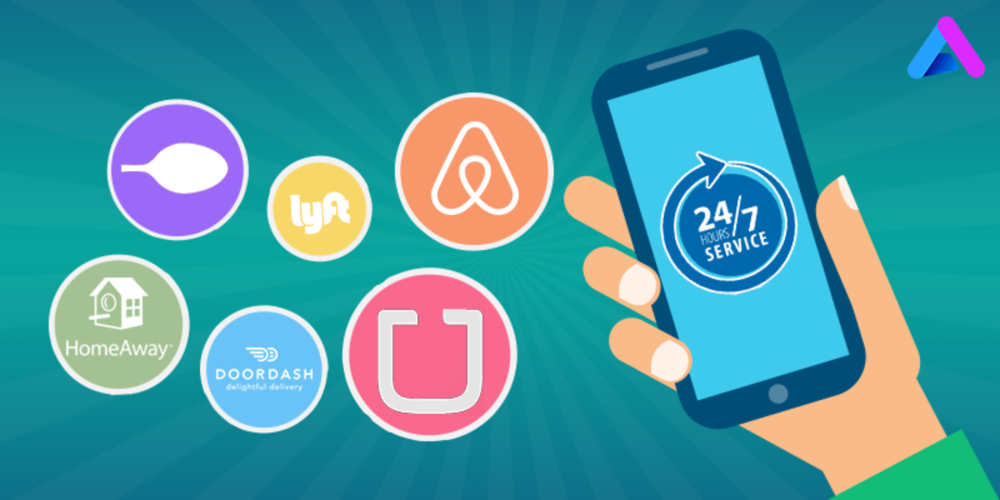The on-demand economy continues to grow at a rapid pace, with reports finding an on-demand economy attracts 22.4 million consumers annually, who spend $57.6 billion total. Half of the on-demand users are millennials, suggesting the on-demand economy is here to stay.
Now that companies like “Uber” and “Airbnb” have become firmly entrenched in our vocabulary, consumers have started to expect a more instantaneous response to their desire for good and services.
As a result, the on-demand economy and its ability to provide consumers an instantaneous result has been a boon to many industries. However, other industries find themselves at a crossroads, struggling to compete with the on-demand economy.
Industries Benefiting from the On-Demand Economy
1. Food and Meal Prep
Few industries benefit from the on-demand economy more prominently than the food and meal prep industry. Delivery services like Eat24 and Seamless partner with thousands of restaurants to make food delivery easy – consumers can order what they want without speaking on the phone.
Many of these services also provide meticulous estimates for the delivery. For example, you can see the stage of your food delivery process when waiting for a Domino’s delivery.
Beyond food delivery, meal prep services like Blue Apron are also exploding in popularity – an average customer’s revenue totals over $200. The idea behind Blue Apron and other ingredient-and-recipe meal kit services is to provide consumers with what they need to cook a meal, without the nuisance of going to the grocery store. The niche touches a market that may deem takeout as unhealthy or limited in options, though still embraces on-demand food servicing.
In addition to Blue Apron, several businesses excel at a more niche-driven form of food and meal prep on-demand delivery. For example, Sincerely Nuts delivers a variety of nuts and treats to your doorstep – think dried fruit, seeds, chocolate and candy. For a style of food like this, where storage and timeliness aren’t as sensitive as meat or seafood, the company’s service flourishes in the on-demand economy.
2. Hyperlocal Delivery
The on-demand economy is proving disruptive to national corporations that rely on an encompassing approach. Instead, the on-demand economy pursues a hyperlocal approach. A service like Uber Eats lets consumers enlist someone local to pick up food for them.
Similar to Giant Food Stores Peapod Service, local grocery chains also offer services that let someone else do your grocery shopping for you. For their service, the individual picking up and delivering the food charges commission from both the store owner and the consumer.
Hyperlocal providers present a win-win approach for all parties, with the consumer receiving their on-demand request, the delivery person receiving profit from their work and the store owner receiving business. All parties benefit without the presence of a large-corporation middleman. Plus, hyperlocal providers can help deliver anything from food to clothing to furniture.
3. Home Services
Homeowners know that maintenance and repairs are never-ending. Whenever something appears resolved, another issue elsewhere in the home tends to arise. As a result, home services never suffer for business.
The on-demand economy serves as an extra benefit to home services, ranging from plumbers and electricians to beauticians. With the on-demand economy, consumers can order a plumber or electrician with ease. Sites act as a middleman to help link consumers with on-demand home service providers and provide consumer reviews and pricing for due diligence.
Industries Negatively Impacted By the On-Demand Economy
1. Taxi Industry
It hasn’t come as much of a shocker to see the taxi industry’s battle with Uber and other aspects of the on-demand economy. In some cities, a taxi license can cost over $1 million to obtain, which has caused some issues.
The impact yields harsh results for a taxi driver or company that has paid loans to afford their taxi license, only to have their service disrupted by the on-demand economy. The accessibility and often lower prices of Uber and Lyft seem to win over the target demographic of old-school taxi services.
2. Logistics
Businesses are well aware that data is pivotal when delivering an item smoothly and precisely. Specifically, logistics help businesses determine a variety of things about the transportation of their goods, ranging from delivery status to information about a driver’s insurance.
The logistics industry is experiencing disruption from on-demand services like My Truck Buddy, a logistics tool that helps truckers log hours, food and fuel details, location, accuracy and more. Deliv is another on-demand tool impacting the industry, providing same-day delivery service by connecting customers with retailers of various channels.
In the past, businesses may have excelled at providing logistics solutions, but the on-demand economy enables delivery providers to track and ensure deliveries with meticulousness.
Although some industries experience a negative impact from the on-demand economy, the majority of consumers embrace the instantaneous and transparent services and goods, especially in the millennial age group.








